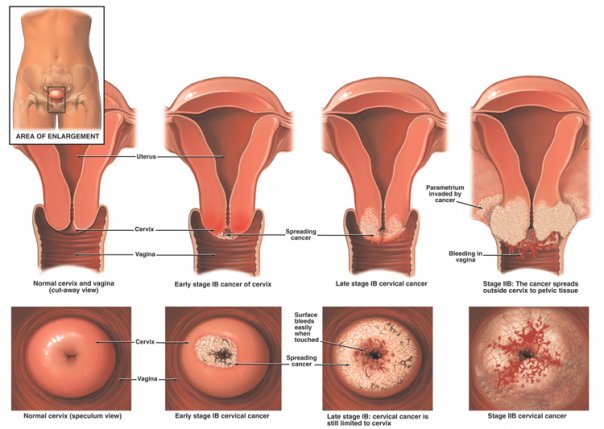Forty years ago cervical cancer ranked as the number one cause of cancer death for women living in the United States. Thanks in part to increased awareness and women receiving regular Pap tests, the number of cervical cancer victims has decreased dramatically over the years. In 2011, approximately 4,000 women died of cervical cancer in the U.S. A stark contrast when compared to the over 39,000 women who died due to breast cancer.

While this remarkable turn around in cervical cancer deaths demonstrates the profound difference increased awareness can make, women everywhere must be careful not to lose sight of the dangers the disease presents. It’s human nature to focus less on those health related issues that don’t receive the same kind of public awareness and attention that constantly reminds us of the dangers they present. This means women need to stay informed about the causes and symptoms of cervical cancer so the nation’s morality rates can remain low.
What is Cervical Cancer?
As with any cancer, cervical cancer begins with the growth of abnormal cells. Forming in a women’s cervix, the abnormal cells begin to invade surrounding healthy tissue and organs in the body. The invasive nature of cervical cancer allows the disease to easily metastasis throughout the body to such organs as the liver, bladder, and lungs.
Fortunately for women, cervical cancer grows very slowly. Most women diagnosed with precancerous cell growth in the cervix are in their 20s and 30s, but the average age for women to actually developed and be diagnosed with cervical cancer is in the mid 50s. The lengthy development of the disease provides plenty of opportunity for early detection, prevention, and treatment. Methods used to detect cervical cancer have improved over the decades, but regardless of how effective detection methods become, they only work if women get tested.
What Causes Cervical Cancer?
Researchers have tied the growth of abnormal cells in the cervix directly to the sexually transmitted disease human papillomavirus (HPV). Since HPV is a STD, women who engage in sex at an early age, have multiple partners, or take oral contraceptives are at a greater risk of developing cervical cancer, because of the increased risk of contracting a STD these activities represent. Certain forms of HPV can cause the growth of a variety of skin and genital warts, and can lead to other skin disorders. These side effects of the disease should be taken as an early warning sign for being at an increased risk of cervical cancer.
Smoking can also contribute to cervical cancer, as the chemicals contained in cigarettes can interact with the cells in the cervix, and cause precancerous changes to occur over time. Studies show that female smokers are between a two and five times more likely to develop cervical cancer than non-smokers.
The Symptoms of Cervical Cancer
Like most forms of cancer, many women who receive a cervical cancer diagnosis present no visible signs or symptoms of the disease until it has developed to advanced state. At this stage, the symptoms of cervical cancer may manifest as the following.
- Abdominal and pelvic pain
- Abnormal vaginal discharge
- Vaginal bleeding at times other than during menstruation
- Kidney failure
By the time these symptoms have begun to manifest, a distinct possibility exists that the disease has progressed to a serious stage, and could have possibly spread to other parts of the body. The fact that cervical cancer does not manifest symptoms until it’s too late should only underscore the importance for women to receive regular checkups from their doctor.
Medicine has come a long way dealing the cervical cancer, but women must still remain vigilant to make sure the number of people the disease claims each year continues to go down.
Timothy Lemke blogs about health and family for Dr. Justin Maricosta, a dentist in Tigard at TenderCare Family Dental.

